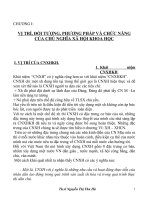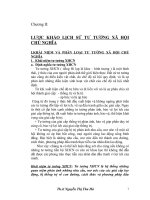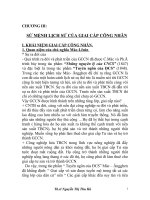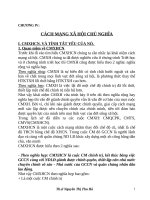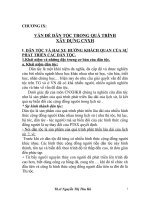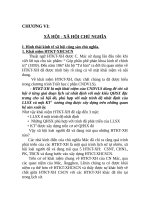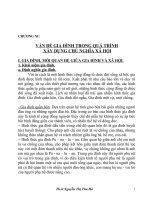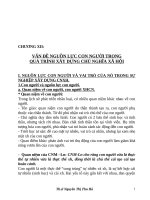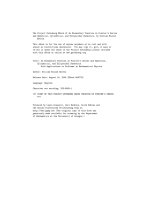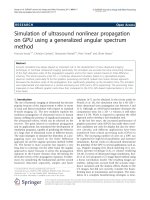On fourier kontorovich lebedev generalized convolution transforms
Bạn đang xem bản rút gọn của tài liệu. Xem và tải ngay bản đầy đủ của tài liệu tại đây (1.15 MB, 14 trang )
Integral Transforms and Special Functions
ISSN: 1065-2469 (Print) 1476-8291 (Online) Journal homepage: />
On Fourier – Kontorovich–Lebedev generalized
convolution transforms
Nguyen Minh Khoa, Nguyen Thanh Hong & Vu Kim Tuan
To cite this article: Nguyen Minh Khoa, Nguyen Thanh Hong & Vu Kim Tuan (2017): On Fourier
– Kontorovich–Lebedev generalized convolution transforms, Integral Transforms and Special
Functions, DOI: 10.1080/10652469.2017.1281922
To link to this article: />
Published online: 29 Jan 2017.
Submit your article to this journal
View related articles
View Crossmark data
Full Terms & Conditions of access and use can be found at
/>Download by: [Dr Nguyen Thanh Hong]
Date: 30 January 2017, At: 17:40
INTEGRAL TRANSFORMS AND SPECIAL FUNCTIONS, 2017
/>
Research Article
On Fourier – Kontorovich–Lebedev generalized convolution
transforms
Nguyen Minh Khoaa , Nguyen Thanh Hongb and Vu Kim Tuanc
a Department of Mathematics, Electric Power University, Hanoi, Vietnam; b School for Gifted Students, Hanoi
National University of Education, Hanoi, Vietnam; c Department of Mathematics, University of West Georgia,
Carrollton, GA, USA
ABSTRACT
ARTICLE HISTORY
We deal with several classes of integral transformations of the form
Received 24 October 2016
Accepted 9 January 2017
f (x) → D
R2+
(e−v cosh(x−u) ± e−v cosh(x+u) )f (u)h(v) du dv,
KEYWORDS
where D is a special differential operator. In case D is the identical
operator, we prove a Young type theorem for a generalized convolution operator related to the Fourier and the Kontorovich–Lebedev
integral transforms. In case D is a certain finite order differential operator, we study the unitary property of these transforms and apply
them to solve a class of integro-differential equations. Several classes
of system of integral equations are also considered.
Convolution; Young’s
theorem; Watson’s theorem;
Fourier;
Kontorovich–Lebedev
transform;
integro-differential equation;
system of integral equations
AMS SUBJECT
CLASSIFICATION
33C10; 44A35; 45E10; 45J05;
47A30; 47B15
1. Introduction
The Fourier cosine and the Fourier sine transforms are defined as follows
(Fc f )(y) ≡ Fc [f ](y) =
2
π
(Fs f )(y) ≡ Fs [f ](y) =
2
π
∞
0
∞
0
f (x) cos xy dx =
2 d
π dy
f (x) sin xy dx =
2 d
π dy
∞
0
∞
0
f (x)
f (x)
sin xy
dx,
x
(1.1)
1 − cos xy
dx. (1.2)
x
The first integrals in (1.1) and (1.2) are well-defined for f ∈ L1 (R+ ), while the second
integrals in (1.1) and (1.2) are also well-defined for f ∈ L2 (R+ ) (see [1,2]).
The Kontorovich–Lebedev integral transform and its inverse have the form (see [3–5])
(Kf )(y) = K[f ](y) = g(y) =
f (x) = K −1 [g](x) =
2
π 2x
CONTACT Nguyen Minh Khoa
235 Hoang Quoc Viet, Hanoi, Vietnam
© 2017 Informa UK Limited, trading as Taylor & Francis Group
∞
0
∞
0
Kiy (x)f (x) dx,
(1.3)
y sinh(π y)Kiy (x)g(y) dy,
(1.4)
Department of Mathematics, Electric Power University,
2
N. M. KHOA ET AL.
here the integrals are understood in the mean-square norms with weights, if necessary. For
more properties of the Kontorovich–Lebedev transform and its convolution transforms,
we refer the reader to the references [6–8].
In [9], the following non-commutative convolutions for the Fourier and Kontorovich–Lebedev integral transforms were introduced
(f ∗ h){ c } (x) =
s
1
2
∞
0
∞
0
[e−v cosh(x−u) ± e−v cosh(x+u) ]f (u)h(v) du dv,
x > 0. (1.5)
The existence of the generalized convolutions (1.5) for two functions in L1 (R+ ) with a
weight and their application to solve integral equations of convolution type were studied
in [9]. Specially, in certain function spaces, the generalized convolutions (1.5) satisfy the
following factorization equalities
F{ c } [(f ∗ h){ c } ](y) = (F{ c } f )(y)(Kh)(y),
s
s
s
∀y > 0.
(1.6)
In any convolution (f ∗ h)(x) of two functions f and h, if we fix a function h and let f
vary in a certain function space, then one can study convolution transforms of the type f →
D[f ∗ h], where D is a certain differential operator. The most famous integral transform
constructed by that way is the Watson transform that is related to the Mellin convolution
and the Mellin transform (see [2])
∞
f (x) −→ g(x) =
0
k(xy)f (y) dy.
Recently, several authors have been investigated convolution transforms of this type
(see [10–13]). However, none of these references considered any application to integrodifferential equations. In this paper we are interested in transforms related to the generalized convolutions (1.5), namely, the transforms of the form given in the abstract. For the
case D is the identity operator, in Section 2 we study Young’s theorem and Young’s inequality for these generalized convolutions. In Section 3, for a certain finite order differential
operators D, we obtain a necessary and sufficient condition such that the respective transforms are unitary on L2 (R+ ), and derive the inverse transforms. In Sections 4 and 5, we
solve in closed form a class of integro-differential equations as well as several classes of
systems of two integral equations with the help of these integral transforms.
2. A Young type theorem
In this section, we will prove several norm properties of the generalized convolutions
(1.5). Throughout the paper, we are interested in the following two-parameter family of
Lebesgue’s spaces.
Definition 2.1 (see [9]): For α ∈ R, 0 < β
of all functions f (x) defined in R+ such that
∞
0
α,β
1, p ≥ 1, we denote by Lp (R+ ) the space
|f (x)|p K0 (βx)xα dx < ∞.
(2.1)
INTEGRAL TRANSFORMS AND SPECIAL FUNCTIONS
3
The norm of a function in this space is defined by
f
α,β
L p (R + )
=
∞
|f (x)|p K0 (βx)xα dx
0
1/p
.
Using the asymptotic of the Macdonald function Kν (z) (see [4])
π 1/2 −z
e [1 + O(1/z)],
2z
K0 (z) = − log z + O(1), z → 0,
Kν (z) =
z → ∞,
(2.2)
(2.3)
formula (2.1) can be expressed in an equivalent form
1
0
|f (x)|p | log x|xα dx +
∞
1
|f (x)|p xα−1/2 e−βx dx < ∞.
For the Fourier convolution (see [1])
1
(f ∗ h)(x) = √
F
2π
∞
−∞
h(x − y)f (y) dy,
(2.4)
Young’s theorem and its corollary, the so-called Young inequality are fundamental (see
[14]). We will prove now Young’s type theorem for the generalized convolutions (1.5).
Theorem 2.2 (Young’s Type Theorem): Let p,q,r be real numbers in (1; ∞) such that
0,β
1/p + 1/q + 1/r = 2 and let f ∈ Lp (R+ ), g ∈ Lq (R+ ), 0 < β 1, h ∈ Lr (R+ ), then
∞
0
(f ∗ g){ c } (x)h(x) dx
s
2−1/q f
Lp (R + )
g
0,β
Lq (R + )
h
Lr (R + ) .
Proof: Let p1 , q1 , r1 be the conjugate exponents of p,q,r, respectively, it means
1
1
1
1
1
1
+
= +
= +
= 1.
p p1
q q1
r
r1
Then it is obvious that 1/p1 + 1/q1 + 1/r1 = 1. Put
F(x, u, v) = |g(v)|q/p1 |h(x)|r/p1 |[e−v cosh(x−u) ± e−v cosh(x+u) ]|1/p1 ,
G(x, u, v) = |h(x)|r/q1 |f (u)|p/q1 |[e−v cosh(x−u) ± e−v cosh(x+u) ]|1/q1 ,
H(x, u, v) = |f (u)|p/r1 |g(v)|q/r1 |[e−v cosh(x−u) ± e−v cosh(x+u) ]|1/r1 .
(2.5)
4
N. M. KHOA ET AL.
We have
F(x, u, v)G(x, u, v)H(x, u, v) = |f (u)g(v)h(x)[e−v cosh(x−u) ± e−v cosh(x+u) ]|.
(2.6)
Using the following integral representation for the Macdonald function with a pure
imaginary index (see [4,5,15])
∞
Kiy (x) =
e−x cosh u cos yu du,
0
x > 0,
(2.7)
we easily see that
Hence, K0 (v)
F
p1
Lp1 (R3+ )
=
∞
1
2
K0 (v) =
0
(e−v cosh(x−u) + e−v cosh(x+u) ) du.
K0 (βv) for 0 < β
∞
∞
0
∞
0
0
∞
∞
0
0
1, and
|g(v)|q |h(x)|r |[e−v cosh(x−u) ± e−v cosh(x+u) ]| du dv dx
|g(v)|q K0 (βv)|h(x)|r dv dx
q
= g
(2.8)
r
Lr (R + ) ,
h
0,β
Lq (R + )
(2.9)
and similarly,
H
r1
Lr1 (R3+ )
∞
=
0
∞
∞
0
∞
0
0
∞
0
|f (u)|p |g(v)|q K0 (βv) du dv
p
Lp (R + )
= f
|f (u)|p |g(v)|q [e−v cosh(x−u) ± e−v cosh(x+u) ] du dv dx
q
g
0,β
Lq (R + )
.
(2.10)
On the other hand, in the space Lq1 (R3+ ), using formula (2.8) we have
G
q1
Lq1 (R3+ )
∞
=
∞
0
∞
0
∞
0
∞
∞
2
0
=2 f
0
p
Lp (R + )
|h(x)|r |f (u)|p |[e−v cosh(x−u) ± e−v cosh(x+u) ]| du dv dx
0
h
|f (u)|p |h(x)|r e−v du dv dx
r
Lr (R + ) .
(2.11)
From (2.11), (2.9), and (2.10) we obtain
F
Lp1 (R3+ )
G
Lq1 (R3+ )
H
Lr1 (R3+ )
2(q−1)/q f
Lp (R + )
g
0,β
Lq (R + )
h
Lr (R + ) .
From (2.6) and (2.12), by three-function form of Hölder inequality [14] we have
∞
0
(f ∗ g)(x)h(x) dx
(2.12)
INTEGRAL TRANSFORMS AND SPECIAL FUNCTIONS
5
1 ∞ ∞ ∞
|f (u) g(v) h(x)|[e−v cosh(x+u) + e−v cosh(x−u) ] du dv dx
2 0
0
0
1 ∞ ∞ ∞
=
F(x, u, v)G(x, u, v)H(x, u, v) du dv dx
2 0
0
0
1
F Lp (R 3 ) G Lq (R 3 ) H Lr (R 3 )
+
+
+
1
1
1
2
−1/q
2
f Lp (R+ ) g L0,β (R ) h Lr (R+ ) .
+
q
The proof is complete.
1/(r−1)
Putting h = (f ∗ g){ c }
and replacing r1 by r in (2.5) we obtain the following Young
s
type inequality
Corollary 2.3 (Young’s Type Inequality): Let 1 < p, q, r < ∞, be such that 1/p + 1/q =
0,β
1 + 1/r and let f ∈ Lp (R+ ), g ∈ Lq (R+ ), 0 < β 1, then the generalized convolutions
(1.5) are well-defined in Lr (R+ ), moreover, the following norm estimates hold
(f ∗ g){ c }
s
2−1/q f
Lr (R + )
Lp (R + )
g
0,β
Lq (R + )
.
(2.13)
3. A Watson type theorem
An important branch of the integral transform theory is to study unitary transforms. In this
section, for a special differential operator of finite order D, we give a condition of the kernel
h such that the convolution transformations (3.3) define unitary operators in L2 (R+ ), and
derive the inverse transformations.
0,β
Lemma 3.1 ([9]): Let h ∈ L2 (R+ ), 0 < β 1, and f ∈ L2 (R+ ), then the generalized
convolutions (1.5) satisfy the factorization equalities (1.6). Furthermore, the following generalized Parseval identities hold
2
π
(f ∗ h){ c } (x) =
s
∞
0
(F{ c } f )(y)K −1 [h](y)
s
cos xy
sin xy
dy,
(3.1)
where the integrals are understood in L2 (R+ ) norm, if necessary.
0,β
Theorem 3.2: Let h ∈ L2 (R+ ), 0 < β
1, then the condition
|K −1 [h](y)| =
1
1 + y2
a.e.,
(3.2)
is necessary and sufficient to ensure that the transformations Kh : f → g given by the
following formulas
(Kh f )(x) ≡ g(x) = 1 −
d2
dx2
∞
0
∞
0
(e−v cosh(x−u) ± e−v cosh(x+u) )f (u)h(v) du dv,
(3.3)
6
N. M. KHOA ET AL.
are unitary in L2 (R+ ). Moreover, the inverse transformations can be written in the conjugate
form
f (x) = 1 −
∞
d2
dx2
∞
0
0
¯
(e−v cosh(x−u) ± e−v cosh(x+u) )h(v)g(u)
du dv.
(3.4)
Proof: Sufficiency: Suppose that the function h satisfies the condition (3.2). Applying
Lemma 3.1, it is easy to see that the generalized convolution transforms (3.3) can be written
in the form
g(x) =
2
π
1−
∞
d2
dx2
(F{ c } f )(y)(Kh)(y)
s
0
cos xy
sin xy
dy.
(3.5)
It is well-known that h(y), yh(y), y2 h(y) ∈ L2 (R) if and only if (Fh)(x), (d/dx)(Fh)(x),
∈ L2 (R) (Theorem 68, page 92, [2]), where F is the Fourier transform,
and moreover,
(d2 /dx2 )(Fh)(x)
d2
(Fh)(x) = −F[y2 h(y)](x).
dx2
Therefore, if (1 + y2 )h(y) ∈ L2 (R+ ) then the following formula holds
1−
d2
dx2
(F{ c } h)(x) = F{ c } [(1 + y2 )h(y)](x).
s
s
(3.6)
From the condition (3.2), (1 + y2 )(Kh)(y)(F{ c } f )(y) ∈ L2 (R+ ), and the formula (3.6)
s
yields
g(x) = F{ c } [(1 + y2 )(F{ c } f )(y)(Kh)(y)](x) ∈ L2 (R+ ).
s
s
Applying the Fourier cosine (sine) transform to both sides of the above relation, we have
(F{ c } g)(y) = (1 + y2 )(Kh)(y)(F{ c } f )(y).
s
s
From the condition (3.2), it is easy to see that |(F{ c } g)(y)| = |(F{ c } f )(y)|, a.e., and
s
s
hence, F{ c } f L2 (R+ ) = F{ c } g L2 (R+ ) . Parseval’s equality for the Fourier cosine (sine)
s
s
transform F{ c } f L2 (R+ ) = f L2 (R+ ) shows that f L2 (R+ ) = g L2 (R+ ) , which implies
s
that the transforms (3.3) are unitary. Again from the condition (3.2) we obtain
¯
(1 + y2 )K[h](y)(F
{ c } g)(y) = (F{ c } f )(y),
s
s
a.e.
Thus, in the same manner as above it corresponds to (3.4) and the inversion formulas
of the transforms (3.3) follow.
Necessity: Suppose that the transforms (3.3) are unitary on L2 (R+ ) and the inversion
formulas are defined by (3.4). Then using Parseval’s type identities (3.1), and Parseval’s
identity for the Fourier cosine (sine) transform, we obtain
g
L2 (R + )
= (1 + y2 )(F{ c } f )(y)(Kh)(y)
s
= F{ c } f
s
L2 (R + )
= f
L2 (R + ) .
L2 (R + )
INTEGRAL TRANSFORMS AND SPECIAL FUNCTIONS
7
Therefore, the multiplication operator Mθ [·] with θ (y) = (1 + y2 )(Kh)(y) is unitary on
L2 (R+ ). This is equivalent to |θ(y)| = 1 on R+ a.e., namely
|(Kh)(y)| =
1
1 + y2
a.e.
It shows that h satisfies the condition (3.2). This completes the proof of the theorem.
4. A class of integro-differential equations
Inspite of having many useful applications (see [16]), not many integro-differential equations can be solved in closed form. No application of convolution type transforms for
solving integro-differential equations was considered in recent investigations [10–13]. In
this section, we apply the generalized convolution transforms (3.3) to solve a class of
integro-differential equations, which seems to be difficult to solve in closed form by using
other techniques. We consider the following integro-differential equation
f (x) + (Kh f )(x) = g(x),
f (0) = 0,
(4.1)
lim f (x) = 0.
x→∞
0,β
Here, h(x) = ((1/cosh τ ) ∗ h1 (τ )){ c } (x), and h1 ∈ L1 (R+ ), g ∈ L1 (R+ ) are given,
s
and f is an unknown function.
In order to give a solution of the above problem, note that, for h ∈ L1 (R+ ) such that
h (0) = 0, lim h(x) = 0, the Fourier sine and Fourier cosine transforms of h exist, and
x→∞
(Fs h )(y) =
2
π
=
2
π
∞
0
h (x) sin xy dx
∞
h(x) sin xy
0
−y
∞
h(x) cos xy dx
0
= −y(Fc h)(y),
(4.2)
and similarly,
(Fc h )(y) = y(Fs h)(y).
(4.3)
The convolution for the Fourier cosine transform [1]
1
(f ∗ g)(x) = √
Fc
2π
∞
0
f (u)[g(|x − u|) + g(x + u)] du,
x > 0,
(4.4)
satisfies the following factorization property
Fc [f ∗ g](y) = (Fc f )(y)(Fc g)(y),
Fc
∀y > 0, f , g ∈ L1 (R+ ).
(4.5)
The generalized convolution for the Fourier sine and Fourier cosine transforms [1]
1
(f ∗ g)(x) = √
1
2π
∞
0
f (u)[g(|x − u|) − g(x + u)] du,
x > 0,
(4.6)
8
N. M. KHOA ET AL.
satisfies the factorization equality [1]
∀y > 0, f , g ∈ L1 (R+ ).
Fs [f ∗ g](y) = (Fs f )(y)(Fc g)(y),
1
(4.7)
Theorem 4.1: Suppose the following condition holds
1
1 − 2Fc
cosh3 τ
∗ h1 (τ )
(y) = 0,
{c}
∀y > 0.
(4.8)
Then the problems (4.1) have the unique solutions in L1 (R+ ) that can be written as follows
f (x) = g(x) + (g ∗
{ Fc }
1
)(x),
(4.9)
here, ∈ L1 (R+ ) is defined by
(Fc )(y) =
1
∗ h1 (τ )){c} ](y)
cosh3 τ
.
1 − 2Fc [( 1 3 ∗ h1 (τ )){c} ](y)
cosh τ
2Fc [(
Proof: The Equations (4.1) can be rewritten in the form
f (x) + 1 −
d2
dx2
(f ∗ h){ c } (x) = g(x).
(4.10)
s
Applying the Fourier cosine (sine) transform to both side of (4.10), using the conditions (4.1) and the factorization equalities (1.6) and formulas (4.2), (4.3), we obtain
(F{ c } f )(y) + (y2 + 1)(Kh)(y)(F{ c } f )(y) = (F{ c } g)(y).
s
s
s
Using the formula (see relation (1.9.1) in [3])
1
(y) =
cosh t
Fc
1
π
,
2 cosh( π2y )
we have
(F{ c } f )(y) − (1 + y2 )(F{ c } f )(y)(Kh1 )(y)
s
s
1
π
= (F{ c } g)(y).
s
2 cosh( π2y )
In view of the formula (1.9.4) in [3] we have
(F{ c } f )(y) − 2(F{ c } f )(y)(Kh1 )(y)Fc
s
s
1
cosh3 t
(y) = (F{ c } g)(y),
s
or equivalently,
(F{ c } f )(y) 1 − 2Fc
s
1
cosh3 τ
∗ h1 (τ )
{c}
(y) = (F{ c } g)(y).
s
(4.11)
INTEGRAL TRANSFORMS AND SPECIAL FUNCTIONS
9
From condition (4.8) we get
(F{ c } f )(y) = 1 +
s
1
∗ h1 (τ )){c} ](y)
cosh3 τ
1
1 − 2Fc [(
∗ h1 (τ )){c} ](y)
cosh3 τ
2Fc [(
(F{ c } g)(y).
s
(4.12)
Recall that the Wiener–Levy theorem [17] states that if f is the Fourier transform of
an L1 (R) function, and ϕ is analytic in a neighbourhood of the origin that contains the
domain {f (y), ∀y ∈ R}, and ϕ(0) = 0, then ϕ(f ) is also the Fourier transform of an L1 (R)
function. For the Fourier cosine transform it means that if f is the Fourier cosine transform
of an L1 (R+ ) function, and ϕ is analytic in a neighbourhood of the origin that contains the
domain {f (y), ∀y ∈ R+ }, and ϕ(0) = 0, then ϕ(f ) is also the Fourier cosine transform of
an L1 (R+ ) function.
By the given condition (4.8) the function ϕ(z) = 2z/(1 − 2z) satisfies conditions of the
Wiener–Levy theorem, and therefore, there exists a unique function ∈ L1 (R+ ) such that
(Fc )(y) =
1
∗ h1 (τ )](y)
cosh3 τ
.
1
1 − 2Fc [
∗ h1 (τ )](y)
cosh3 τ
2Fc [
Therefore Equations (4.12) become
(F{ c } f )(y) = (1 + (Fc )(y))(F{ c } g)(y) = F{ c } (g + g ∗
s
s
that imply f (x) = g(x) + (g ∗
{ Fc }
1
s
{ Fc }
1
)(y),
)(x). The proof is complete.
Remark: We can obtain similar results for a general differential operator D =
n
n
k
2k
2k
2k
k=0 (−1) ak (d /dx ) such that the polynomial P(x) =
k=0 ak x has no real zero.
5. Systems of integral equations
(a) Consider the following system of integral equations
λ1 ∞ ∞ −v cosh(x−u)
[e
+ e−v cosh(x+u) ]g(u)h(v) du dv = p(x)
2 0
0
∞
λ2
g(x) + √
[k(u + x) + k(|u − x|)]f (u) du = q(x),
2π 0
f (x) +
(5.1)
where λ1 , λ2 are complex constants, h,k,p,q are given functions in L1 (R+ ), and f,g are
unknown functions.
10
N. M. KHOA ET AL.
Theorem 5.1: If the following condition satisfies
1 − λ1 λ2 Fc [(k ∗ h){c} ](y) = 0,
∀y > 0,
(5.2)
then there exists a unique solution in L1 (R+ ) × L1 (R+ ) of the system (5.1), which is defined
by
f (x) = p(x) − λ1 (q ∗ h){c} (x) + ( ∗ p)(x) − λ1 [(q ∗ h){c} ∗ ](x)
Fc
Fc
(5.3)
g(x) = q(x) − λ2 (k ∗ p)(x) + ( ∗ q)(x) − λ2 [(k ∗ p) ∗ ](x).
Fc
Fc
Fc
Fc
Here is given by (5.5).
Proof: Using (1.5) and (4.4), the system (5.1) can be rewritten in the form
f (x) + λ1 (g ∗ h){c} (x) = p(x),
(5.4)
λ2 (f ∗ k)(x) + g(x) = q(x).
Fc
With the help of the factorization properties (1.6), (4.5), we obtain the linear system of
algebraic equations
(Fc f )(y) + λ1 (Fc g)(y)(Kh)(y) = (Fc p)(y),
λ2 (Fc f )(y)(Fc k)(y) + (Fc g)(y) = (Fc q)(y).
The inverse of the determinant of this system has the form
1
=1+
λ1 λ2 Fc [(k ∗ h){c} ](y)
.
1 − λ1 λ2 Fc [(k ∗ h){c} ](y)
According to the Wiener–Levy theorem [17], there exists a function
that
λ1 λ2 Fc [(k ∗ h)(y){c} ]
(Fc )(y) =
, ∀y > 0.
1 − λ1 λ2 Fc [(k ∗ h)(y){c} ]
Hence 1/
∈ L1 (R+ ) such
(5.5)
= 1 + (Fc )(y). Moreover,
=
1
(Fc p)(y)
(Fc q)(y)
λ1 (Kh)(y)
= (Fc p)(y) − λ1 Fc [(q ∗ h){c} ](y),
1
and
2
=
1
λ2 (Fc k)(y)
(Fc p)(y)
= (Fc q)(y) − λ2 Fc (k ∗ p)(y).
(Fc q)(y)
Fc
Again, using the formulas (1.6), (4.5) we get
(Fc f )(y) =
1
= [1 + (Fc )(y)][(Fc p)(y) − λ1 Fc [(q ∗ h){c} ](y)]
= (Fc p)(y) − λ1 Fc [(q ∗ h){c} ](y) + Fc ( ∗ p)(y) − λ1 Fc [(q ∗ h){c} ∗ ](y).
Fc
Fc
INTEGRAL TRANSFORMS AND SPECIAL FUNCTIONS
11
It follows that
f (x) = p(x) − λ1 (q ∗ h){c} (x) + ( ∗ p)(x) − λ1 ((q ∗ h){c} ∗ )(x) ∈ L1 (R+ ).
Fc
Fc
Similarly,
2
(Fc g)(y) =
= [1 + (Fc )(y)][(Fc q)(y) − λ2 Fc (k ∗ p)(y)]
Fc
= (Fc q)(y) − λ2 Fc (k ∗ p)(y) + Fc ( ∗ q)(y) − λ2 Fc [(k ∗ p) ∗ ](y).
Fc
Fc
Fc
Fc
Consequently,
g(x) = q(x) − λ2 (k ∗ p)(x) + ( ∗ q)(x) − λ2 [(k ∗ p) ∗ ](x) ∈ L1 (R+ ).
Fc
Fc
Fc
Fc
The proof is complete.
(b) Finally, we consider the following system of integral equations
f (x) +
λ2
√
2 2π
λ1
2
∞
0
∞
0
∞
0
[e−v cosh(x−u) + e−v cosh(x+u) ]g(u)h(v) du dv = p(x),
(5.6)
k(y)[f (|x + y − 1|) + f (|x − y + 1|) − f (x + y + 1)
− f (|x − y − 1|)] dy + g(x) = q(x),
where λ1 , λ2 are complex constants, h,p,q are given functions in L1 (R+ ); f,g are unknown
functions; and k(x) = (k1 ∗ k2 )(x), here the generalized convolution · ∗ · is defined
1
1
by (4.6), and k1 , k2 are given functions in L1 (R+ ).
To solve this system of integral equations, we recall the generalized convolution with
the weight function γ (y) = sin y for the Fourier cosine and sine transforms (see [18])
∞
γ
1
(f ∗ g)(x) = √
2
2 2π
0
f (y)[g(|x + y − 1|) + g(|x − y + 1|) − g(x + y + 1)
− g(|x − y − 1|)] dy,
x > 0.
(5.7)
This generalized convolution satisfies the following factorization equality for f , g ∈
L1 (R+ )
γ
Fc (f ∗ g)(y) = sin y(Fs f )(y)(Fc g)(y),
y > 0.
(5.8)
∀y > 0,
(5.9)
2
Theorem 5.2: If the following condition satisfies
γ
1 − λ1 λ2 Fc (k1 ∗ (k2 ∗ h){c} )(y) = 0,
2
then there exists a unique solution in L1 (R+ ) of the system (5.6), which is defined by
f (x) = p(x) − λ1 (q ∗ h){c} (x) + ( ∗ p)(x) − λ1 [ ∗ (q ∗ h){c} ](x),
Fc
γ
Fc
γ
g(x) = q(x) − λ2 (k ∗ p)(x) + ( ∗ p)(x) − λ2 [(k ∗ p) ∗ )](x).
2
Here is given by (5.11).
Fc
2
Fc
(5.10)
12
N. M. KHOA ET AL.
Proof: Using formulas (1.5) and (5.7), the system (5.6) can be rewritten in the form
f (x) + λ1 (g ∗ h){c} (x) = p(x),
γ
λ2 (k ∗ f )(x) + g(x) = q(x).
2
With the help of the factorization properties (1.6), (5.8), we obtain the linear system of
algebraic equations
(Fc f )(y) + λ1 (Fc g)(y)(Kh)(y) = (Fc p)(y),
λ2 sin y(Fs k)(y)(Fc f )(y) + (Fc g)(y) = (Fc q)(y).
We have
λ1 (Kh)(y)
= 1 − λ1 λ2 sin y(Fs k)(y)(Kh)(y)
1
1
λ2 sin y(Fs k)(y)
=
= 1 − λ1 λ2 sin y(Fs k1 )(y)(Fc k2 )(y)(Kh)(y)
γ
= 1 − λ1 λ2 Fc [k1 ∗ (k2 ∗ h){c} ](y).
2
Therefore,
γ
1
=1+
λ1 λ2 Fc (k1 ∗ (k2 ∗ h){c} )(y)
2
γ
1 − λ1 λ2 Fc (k1 ∗ (k2 ∗ h){c} )(y)
.
2
According to the Wiener–Levy theorem [17], there exists a function
that
∈ L1 (R+ ) such
γ
(Fc )(y) =
λ1 λ2 Fc (k1 ∗ (k2 ∗ h){c} )(y)
2
γ
1 − λ1 λ2 Fc (k1 ∗ (k2 ∗ h){c} )(y)
∀y > 0.
,
(5.11)
2
Hence, 1/
= 1 + (Fc )(y). Moreover,
1
=
(Fc p)(y)
(Fc q)(y)
λ1 (Kh)(y)
= (Fc p)(y) − λ1 Fc (q ∗ h){c} (y),
1
and
2
=
1
λ2 sin y(Fs k)(y)
γ
(Fc p)(y)
= (Fc q)(y) − λ2 Fc (k ∗ p)(y).
(Fc q)(y)
2
Hence,
f (x) = p(x) − λ1 (q ∗ h){c} (x) + ( ∗ p)(x) − λ1 [ ∗ (q ∗ h){c} ](x),
Fc
γ
Fc
γ
g(x) = q(x) − λ2 (k ∗ p)(x) + ( ∗ p)(x) − λ2 [(k ∗ p) ∗ )](x).
2
Fc
2
Fc
It is clearly that the solution f,g defined as above are functions in L1 (R+ ). The proof is
complete.
INTEGRAL TRANSFORMS AND SPECIAL FUNCTIONS
13
Disclosure statement
No potential conflict of interest was reported by the authors.
References
[1] Sneddon IN. Fourier transforms. New York: McGray-Hill; 1951.
[2] Titchmarsh EC. Introduction to the theory of Fourier integrals. 3rd ed. New York: Chelsea
Publishing Co.; 1986.
[3] Bateman H, Erdelyi A. Table of integral transforms, Vol. I. New York: McGraw-Hill; 1954.
[4] Glaeske HJ, Prudnikov AP, Skornik KA. Operational calculus and related topics. Raton:
Chapman & Hall/CRC; 2006.
[5] Wimp J. A class of integral transforms. Proc Edinb Math Soc. 1964;14:33–40.
[6] Yakubovich SB, Luchko Yu. The hypergeometric approach to integral transforms and convolutions. Mathematics and its applications, Vol. 287. Dordrecht: Kluwer Academic Publishing;
1994.
[7] Yakubovich SB. On the Kontorovich-Lebedev transformation. J Integral Equations Appl.
2003;15(1):95–112.
[8] Yakubovich SB. Boundedness and inversion properties of certain convolution transforms. J
Korean Math Soc. 2003;40(6):999–1014.
[9] Yakubovich SB, Britvina LE. Convolutions related to the Fourier and Kontorovich-Lebedev
transforms revisited. Integral Transforms Spec Funct. 2010;21(4):259–276.
[10] Al-Musallam F, Tuan VK. Integral transforms related to a generalized convolution. Results
Math. 2000;38:197–208.
[11] Britvina LE. A class of integral transforms related to the Fourier cosine convolution. Integral
Transforms Spec Funct. 2005;16(5–6):379–389.
[12] Tuan VK. Integral transforms of Fourier cosine convolution type. J Math Anal Appl.
1999;229:519–529.
[13] Yakubovich SB. Integral transforms of the Kontorovich-Lebedev convolution type. Collect
Math. 2003;54(2):99–110.
[14] Adams RA, Fournier JJF. Sobolev spaces. 2nd ed. New York: Academic Press; 2003.
[15] Abramowitz M, Stegun IA. Handbook of mathematical functions, with formulas, graphs and
mathematical tables. National Bureau of Standards Applied Mathematics Series. Washington
(DC): United States of America Dover Publications, Inc.; 1964.
[16] Grigoriev YN, Ibragimov NH, Kovalev VF, Meleshko SV. Symmetries of integro-differential
equations with applications in mechanics and plasma physics. Lect Notes Phys. Dordrecht:
Springer; 2010.
[17] Paley REAC, Wiener N. Fourier transforms in the complex domain. New York: AMS; 1934.
[18] Thao NX, Tuan VK, Khoa NM. A generalized convolution with a weight function for the
Fourier cosine and sine transforms. Fract Calc Appl Anal. 2004;7(3):323–337.
